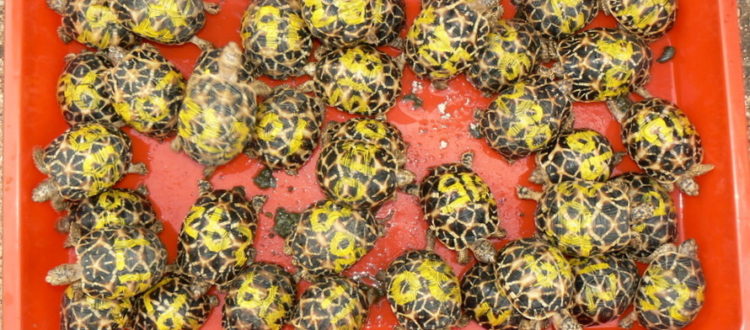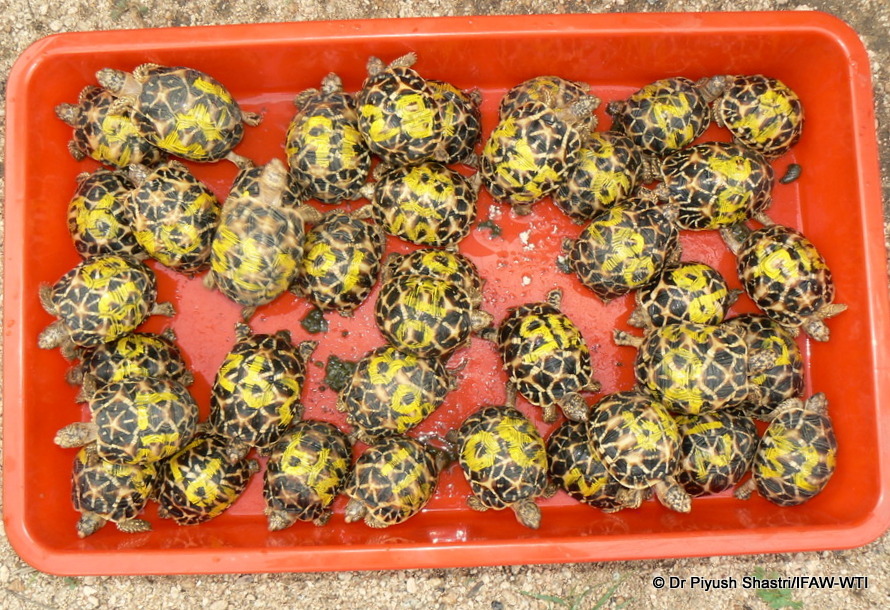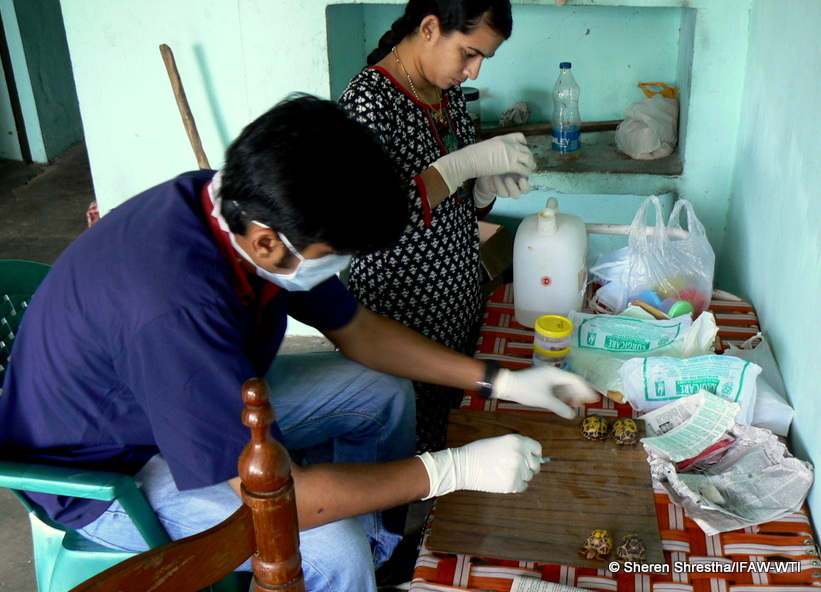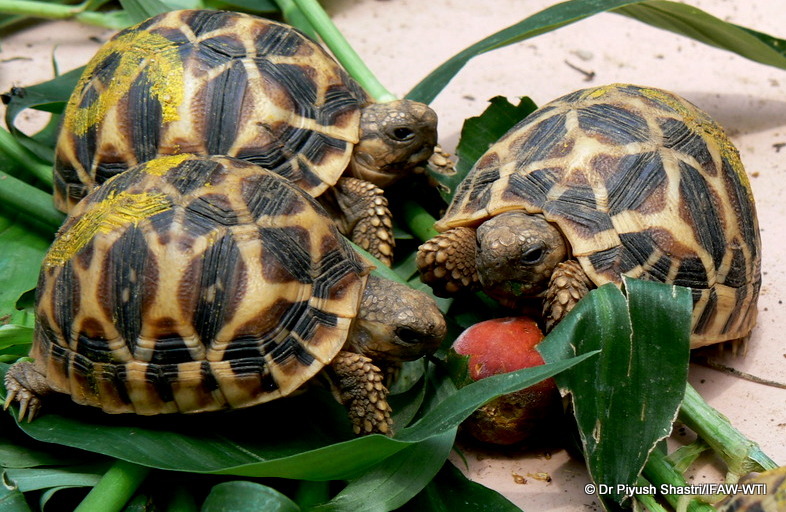The Stars are Wild Again
We walked almost a kilometre from the place where we left the jeep. The evening sun was still hot and signs of the forthcoming summer were around. Gopalan, the local watcher was walking ahead, occasionally stopping and checking for elephants that could give us all a surprise welcome! We were inside Chinnar Wildlife Sanctuary, in the Southern Indian state of Kerala, walking to a secret location which only Gopalan knew.
Gopalan was not just leading us through the forest, but was also carrying a precious cargo with him. A small cotton bag carefully secured in his hand had nine live star tortoises, and we were going to release them in the wild after a year long rehabilitation. Like most superstitious traditional Indians, who believe in stars and planets, we had decided to carry nine star tortoises as an auspicious beginning of the release programme. Yes, we were there to initiate the final stages of the rehabilitation of the star tortoise back to wild.
It was last year on April 30, 2014 when 461 star tortoises were seized by the customs officials at Thiruvanathapuram airport from a passenger who was trying to smuggle them out of the country. The suspect was arrested and the tortoises were handed over to the zoo.
The Emergency Relief Network (ERN) division of International Fund for Animal Welfare (IFAW) –Wildlife Trust of India (WTI) got into action from the day of the seizure itself. We wanted these animals to go back to wild instead of ending up in a zoo. Paperwork was done in record time by the Kerala Forest Department, and Chinnar was selected as the rehabilitation location as it is a known star tortoise distribution area. Sadly, by the time they reached the rehabilitation centre only 357 had survived.
Dr Amit Malick, IFS, Chief Conservator of Forest and Wildlife, was more than keen to send the tortoises back to wild. His love for them was visible to all with a painting of tortoise on his office door and a sticker on his laptop. Professing his love for tortoise he said, “As a kid, I had tortoises as pets and may be that childhood love affair is what is still going on.” When I heard this from the Director of a famous Tiger Reserve with an aura of seriousness around him, I was bit amused.
Dr Nameer PO, a qualified rehabilitator and Professor of Wildlife Sciences from the Kerala Agricultural University, was the next to join the team as a technical expert. His student Maya joined as the field assistant who stayed at Chinnar to undertake the entire rehabilitation process, along with IFAW-WTI ERN veterinarian Dr Piyush Shastri who provided the veterinary care to the star tortoises.
The tortoise arrived at Chinnar from the zoo as soon as the legal formalities were completed and they were housed in a secure building with round the clock security. Problem was that the regional newspapers had started publishing stories about the seized star tortoise being shifted to Chinnar and that each tortoise was priced at about $5000 in the international market!
“It was a actually a security concern for us in the beginning as we even feared about someone attempting to steal them from the holding place. We had no other option but to keep a few guards on round the clock duty to ensure the protection of the animals “ said Prasad G, Wildlife Warden, Munnar Wildlife Division.
As IFAW-WTI had undertaken rehabilitation of star tortoises in the past, we had a set of protocols ready in hand but had to innovate and adapt as per the ground situation.
“Our plan was to move the tortoise into open enclosures in the campus, where they would be exposed to elements of nature like wind , sunlight and rain, so that they would get used to their natural environment at the earliest‘’, said Dr Nameer, his words reflecting the entire strategy of the rehabilitation. “ We were already facing mortality issues from the day of seizure. These hatchlings were under stress and had already picked up infections. Timely medical intervention and proper husbandry care controlled the mortality”, added Dr Piyush Shastri, IFAW-WTI ERN veterinarian.
Feeding these hatchlings was the first challenge we faced since the vegetation at Chinnar was different from the vegetation at the rehabilitation location. All we were sure about was that Opuntia, a preferred diet of the star tortoise, was available in plenty. The tortoises were supplied with chopped pieces of tender Opuntia stems beforehand to habituate them.
That was when Gopalan walked into the project.
I still remember Gopalan accidently coming to the rehabilitation site, after his visit to the nearby town which is few kilometers away. It was his day off – he worked as a watcher with the Forest Department and belonged to the tribal community of Chinnar. Sibin – the Range Officer was the first one to suggest that we should ask Gopalan on what these tortoises eat in the wild. His reason was simple,“Gopalan is a very good wildlife observer, he walks around the forest and always has a keen eye for observing wild animals”.
Sibin was right. When we asked Gopalan about the tortoise and what they eat, the naturalist in Gopalan emerged. He transformed into a professor of star tortoise’s habitat usage and behaviour for all of us. He talked about where they live, what they eat, how they eat and when they eat. He knew not only about the part of the sanctuary where they are found, but also on how they lay eggs and when the hatchlings come out! Then as if to mock all of us and our protocols, he walked around the place and came with a handful of plants and crushed a few of them and placed them into the enclosure for the tortoises. He knew the name of each plant in the local language and pointed out to the two plant species which are preferred by the tortoise.
And he was not at all wrong, as we watched, the star tortoise abandoned eating the Opuntia and moved towards the new pile of plants that were dropped by Gopalan. They began eating without any delay while we stood and watched.
From then on there was no looking back and suddenly it was time for the star tortoise to go back to their original home. From February 2015 onwards, 178 star tortoises were released in nine batches back to the wild.
And, just when the old ones went back to the wild we received the news that last week 200 star tortoises were seized by the customs authorities at the Kochi airport and were being sent to the Chinnar rehabilitation centre. Life does come a full circle.
Blog by :- Jose Louies, Regional Head, South India, WTI












